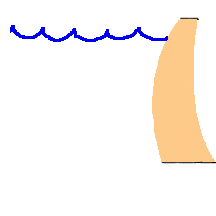 |
What are the forces
on an arch dam? |
These are the main forces on a dam.
Roll over each force to see it on the dam.
Click on each one to learn more about it:
|
 |
There are many other forces that may act on an arch dam:
- there may be water on the downstream side of the dam as well; this water
will have the same sort of vertical and horizontal forces on the dam as the
water on the upstream side
- internal hydrostatic pressure: in pores, cracks, joints, and seams
- temperature variations
- chemical reactions
- silt pressure; silt will build up over time on the upstream side; silt
provides about 1.5 times the horizontal pressure of water and twice the
vertical pressure of water
- ice load on the upstream
side
- wave load on the upstream side
- earthquake
loads
- settlement of the foundation or abutments
- other structures on top of the dam -- gates, a bridge, cars
- creep of concrete: deformation of the concrete when under a constant load
for a long period of time.
|

|
Forces on a dam in a simuation
You must tell the computer program
where the dam feels forces. You won't include all of the possible forces on
the dam on the first simulation; just try to include the main ones to get a
feel for the general behavior of the dam. Then include some other forces
on the dam to get an idea of which ones matter.
|
|
Here, the forces are signified by the yellow
dots. First, on the left hand edge, the dam feels the force of the water.
Second, in the middle, the dam feels the weight of the concrete
at a single point (it really should be at the centroid). The force of the
water and the weight of the concrete are the two most important forces to
include in your simulation. Along the bottom edge, the red dots tell the
program that the dam is fixed to the foundation.
Most dams have drainage that reduces the uplift force, so you don't need to include
this force in your simulation.
|
  |


